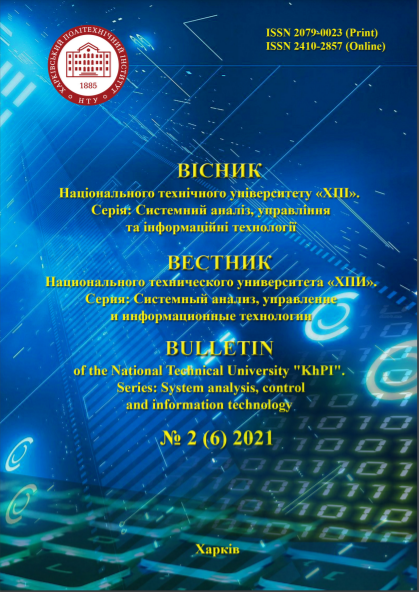HUMAN BODY MODELING TECHNOLOGIES FOR E-COMMERCE SYSTEMS
DOI:
https://doi.org/10.20998/2079-0023.2021.02.06Keywords:
3D model, 3D graphics, anatomical model, online commerce, ReactJS, ThreeJSAbstract
Relevance of the research work is the analysis of the main features of 3D modeling for further implementation in e-commerce. Namely, the features of
creating a human body 3D model with the ability to edit personal settings of individual parts of the body, as well as a basic set of clothes to provide a
more realistic representation of the model. The features of the 3D model in general were considered in this article. The mathematical analysis of the 3D
graphics rendering on the 2D monitor and the possibilities of control and editing of such models have been presented. The developed software product
allows the user to create an anatomical three-dimensional model of the human body and then adjust it to his needs. The user can apply on created
model variety of settings, namely more than 15 different views, with a full package of changes. It is possible to change the size, color of hair,
eyebrows, eyes, face, body, legs. Also, the user is able to select the levels of skeletal frame views and additionally can select different backgrounds to
provide a more realistic representation of the model in space. Additional functionality was implemented for more flexible configuration of the model’s
face. The user can pre-determine points to select directions or sizes of different parts of the face using settings, displayed on the mouse or touchpad
control. After adjustments, the user is able to manage the clothes that he had saved in the shopping cart from the online store, from which he later
proceeded to the online fitting. After the fitting the user can test the creation of animations in 360 degrees of free movement. Finally, the user can go to
the store to pay for the items he left in the shopping cart. Developed software allows improving main metrics of the on-line stores, which has a positive
impact on increasing the growth of earnings.
References
Simona J., Stjepanovič Z., Rudolf A. 3D Virtual Prototyping of Garments: Approaches, Developments and Challenges. Journal of Fiber Bioengineering and Informatics. 2017. no 10 (1). pp. 51–63.
Zhu X., Rätsch M., Lu Н. An interactive clothing design and personalized virtual display system. Multimedia Tools and Applications. 2018. no 77. pp. 27163–27179.
Lagе A., Ancutienе K. Virtual try-on technologies in the clothing industry: basic block pattern modification. International Journal of Clothing Science and Technology. 2019. no 31 (6). pp. 51–63.
Ancutienе K. Simulation of mechanical behavior of fibrous materials using 3d virtual prototyping. Proceedings IRF2020: 7th International Conference Integrity-Reliability-Failure. 2020. pp. 77–78.
Liu Zh. L. S., Zhao X. Big data and digital design models for fashion design. Journal of Engineered Fibers and Fabrics. 2021. no 16. pp. 51–63
Leiming L., Wenyao Zh., Hongwei H. Multivisual Animation Character 3D Model Design Method Based on VR Technology. Hindawi Complexity. Complexity Problems Handled by Advanced Computer Simulation Technology in Smart Cities. 2021. no 2021. Available at https://doi.org/10.1155/2021/9988803 (access date: 23.10.2021).
Abrash M. Graphics Programming Black Book. Coriolis Group, 2002. 1342 p.
Matsuda K., Li P. WebGL: programmirovaniye trekhmernoy grafiki [WebGL: 3D graphics programming]. M., DMK Press, 2019. 493 р.
Arshad M. R., Manaf A., Yoon K. H. Physical Rigging Procedures Based on Character Type and Design in 3D Animation. International Journal of Recent Technology and Engineering. 2019. no 8(3). pp. 4138–4147.
Pettineo M. Using Bindless Resources with DirectX Raytracing. Available at https://link.springer.com/chapter/10.1007/978-1-4842- 7185-8_17 (access date: 24.10.2021).
Gaydukov S. A. OpenGL. Professional’noye programmirovaniye trekhmernoy grafiki na C++ [Professional 3D graphics programming using C ++]. BKHV-Peterburg, 2004. 736 p.
Boreskov A. V., Kharlamov A. A. Osnovy raboty s tekhnologiyey CUDA [Basics of working with CUDA technology]. M., DMK Press, 2016. 230 p.
Downloads
Published
How to Cite
Issue
Section
License
LicenseAuthors who publish with this journal agree to the following terms:
- Authors retain copyright and grant the journal right of first publication with the work simultaneously licensed under a Creative Commons Attribution License that allows others to share the work with an acknowledgement of the work's authorship and initial publication in this journal.
- Authors are able to enter into separate, additional contractual arrangements for the non-exclusive distribution of the journal's published version of the work (e.g., post it to an institutional repository or publish it in a book), with an acknowledgement of its initial publication in this journal.
- Authors are permitted and encouraged to post their work online (e.g., in institutional repositories or on their website) prior to and during the submission process, as it can lead to productive exchanges, as well as earlier and greater citation of published work (See The Effect of Open Access).


